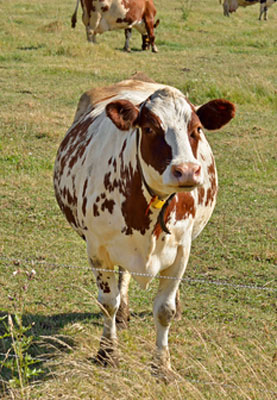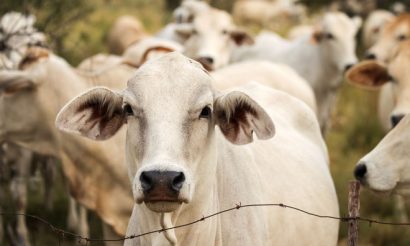Compost bedding good for cow claw health
- Like
- Digg
- Del
- Tumblr
- VKontakte
- Buffer
- Love This
- Odnoklassniki
- Meneame
- Blogger
- Amazon
- Yahoo Mail
- Gmail
- AOL
- Newsvine
- HackerNews
- Evernote
- MySpace
- Mail.ru
- Viadeo
- Line
- Comments
- Yummly
- SMS
- Viber
- Telegram
- Subscribe
- Skype
- Facebook Messenger
- Kakao
- LiveJournal
- Yammer
- Edgar
- Fintel
- Mix
- Instapaper
- Copy Link
Posted: 4 November 2016 | University of Veterinary Medicine, Vienna | No comments yet
Dairy cows kept in barns often develop claw damage because of humid and unsuitable roaming areas. The University of Veterinary Medicine, Vienna explore…


Dairy cows kept in barns often develop claw damage because of humid and unsuitable roaming areas.


These disorders can affect the animals’ fertility or their milk production. A study conducted by researchers from Vetmeduni Vienna now shows that the use of wood shavings and sawdust in dairy barns instead of straw bedding was especially good for claw health.
A comparison with other barn types demonstrated that cows kept in compost bedded barns exhibited a lower frequency and lesser severity of claw disorders. The results were published in The Veterinary Journal.
The comfort and well-being of the animals is an important consideration when dairy cows are kept in barns. The freedom afforded by loose housing systems such as free-stall cubicle barns promotes the natural behaviour and health of the animals. The widespread switch from tie-stall housing to loose housing has seen a change in the type of claw lesions, but the frequency of claw disorders has been on the rise.
Wood chips and sawdust instead of straw
International studies have identified the compost bedded barn as the beneficial for claw health. Compost bedded barns use wood chips or sawdust as bedding instead of straw. The wood residue binds the excrement and daily aerating incorporates the manure and starts the composting process. This makes an even concrete floor important in the roaming area. Slatted flooring, in which manure and urine fall into a separate area beneath the floor, should only be installed in the feed alley. Fresh bedding should also be added daily following aeration.
A team of researchers from Vetmeduni Vienna, led by Johann Burgstaller from the Clinical Unit of Ruminant Medicine, has for the first time compared the frequency of claw disorders and lameness in compost bedded barns and the more common freestall cubicle barns in Austria. The researchers investigated the frequency and severity of claw lesions in five compost bedded barns and five freestall barns. “Lesions of low severity were categorised as grade 1, severe lesions as grade 3. The results for the individual lesions were weighted and subsequently added together to calculate an index value for the claw health per barn,” Burgstaller explains.
“A high value indicates poor claw health; a low value indicates good claw health. This value, however, is also influenced by factors such as frequency of care, feeding and genetics.”
Compost bedding reduces the number of cases of claw lesions
The compost bedded barns exhibited about one half the number claw disorders, such as foot rot or white line disease, as the freestall barns. Both the frequency and severity were lower. Lesions of grades 2 and 3 were seen only rarely. The compost bedding thus has a proven beneficial effect on claw health. Lameness, on the other hand, occurred at nearly the same frequency in both barn types. At about 18 percent, however, the average of the freestall and compost bedded barns was below the international and previous Austrian level of 25 percent.
Humid bedding contributes to claw disorders
Even if modern barn types give dairy cows more freedom to roam, the animals must still stand in manure and urine for longer periods of time. The excrement increases the floor humidity and has negative consequences for claw health. The result are claw lesions, such as foot rot or white line disease.
“Floor humidity softens the skin between the claws, which makes it susceptible to bacterial infections. The reduced horn quality can lead to lesions and, in serious cases, sole haemorrhages,” Burgstaller explains.
White line disease occurs when floor humidity attacks the sensitive junction between the sole and the wall of the claw. Sudden or rotating movements create pressure on the affected junction and the sole slowly separates from the wall. This type of claw disorder is one of the main causes of lameness.
Compost bedded barns allow more social interaction
Compost bedded barns that are aerated and refilled daily can counter claw damage over the long term. This requires more work and effort on the part of the farmers. But after one year of composting, they can use the bedding as fertiliser. According to Burgstaller, the situation for dairy cows living in freestall barns can also be improved with more frequent re-bedding to keep the area dry.
The main difference between the compost bedded barn and the freestall barn is that the former has just one large area for roaming. “There are no cubicles. This is more in keeping with the pronounced social behaviour of cattle,” Burgstaller explains. A dairy herd is organised hierarchically. If a cow is forced to leave its place for an animal of a higher rank, it can get up quickly and move out of the way without any obstacles. The stable and nonslip surface also allows weaker animals to get up or lie down safely, which is an enormous advantage in cases of milk fever.




